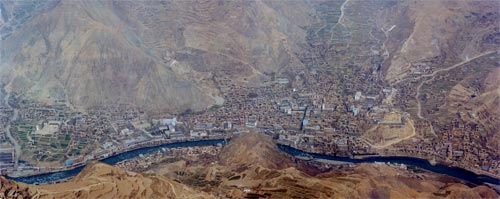UPDATE: According to AFP, the official number of those who died following an avalanche of mud and rock in Drugchu has been revised to 1,254, with 490 still missing. Much needed medicine and supplies are unable to reach the affected area because of roads still blocked as a result of the mudslide, forcing survivors to walk to aid distribution centers for fresh water and supplies. Officials have also warned of torrential rains from August 16 – August 18 that could cause further flooding in the area. (See: ‘China mudslide town lacking supplies,’ AFP, August 16, 2010)
The death toll has risen to 702 after an avalanche of mud and rock swept through Drugchu, a Tibetan area of Gansu province in north-western China, on Sunday (August 8). 1,042 people are still missing and 42 seriously injured, the state news agency, Xinhua, reported today (August 10).
The landslide demolished a large section of the town of Drugchu (Chinese: Zhouqu) in the south-east of Kanlho (Chinese: Gannan) Tibetan Autonomous Prefecture in Gansu, and then poured into a river, damming the waterway and causing it to flood and submerge part of the town. The Chinese military have used explosives to clear the blockage and drain the town, and efforts to dig people out of the rubble are ongoing. According to a CNN report from the area, more than 10,000 survivors are now living in tents after their homes were obliterated.
Frantic efforts are being made to drain the unstable lake created by the landslide amid fears it could burst and swamp devastated areas where rescue attempts are still being made.
The devastation in Drugchu is the second calamity to hit Tibetans in recent months. In April, a 7.1 earthquake struck the Tibetan area of Yushu, Kham in present-day Qinghai province and killed 2,698, according to official estimates (ICT report, Hundreds killed in earthquake in Kyigundo, eastern Tibet: emergency appeals launched – April 14, 2010).
A panorama of Drugchu (see below) shows the town’s location below dry, deforested mountains. This panorama, created from scanned images of photographic negatives taken 15 years ago, shows how complete deforestation was more than a decade ago and how even the steepest slopes were re-sculpted to create space for agriculture. According to various reports, local people and officials have warned for years that heavy tree-felling and rapid development were making the mountain area around Drugchu more vulnerable to landslips. According to The Guardian, one government report last year called the Bailong river a “high-occurrence disaster zone for landslides” (The Guardian, China landslide raises fear of dam bursting).
In a vivid description of the landscape, Al Jazeera’s China correspondent, Melissa K Chan, sent a twitter message from the area yesterday reporting: “Naked mountains, no trees or shrubs. Erosion. No wonder these mudslides happened in Zhouqu, Gansu.” (http://twitter.com/melissakchan). Melissa Chan also reported today: “Residents say the mudflow came down and buried everything in about ten minutes. Wasn’t raining at time — had no idea of danger. Smell the stench of bodies and see and hear wailing relatives mourning the dead. An awful way to die buried alive.”
The state media reported that the landslide is the worst to hit China in six decades. A tropical storm is now heading for northern China, and is expected to bring strong rains back to the disaster area.
The Tibetan Parliament in exile stated that Tibetans in the area blamed environmental mismanagement by the authorities in addition to heavy rainfall. (www.tibet.net).
In their account of the area in the CD-Rom Tibet Outside the TAR (TOTAR), Steve Marshall and Susette Cooke write: “Viewed from above, the county town of Drugchu might be a growth on the surface of the landscape, clustered along the edge of the Bailong River and climbing up into side valleys below the dry sculpted hills. Above these rise even higher bony mountain ridges, where a few patches of conifers suggest a once damper and more forested landscape. The town consists of a Chinese-modern center with a few outlying islands of high-rise construction, connected by low-rise residential neighborhoods merging into the surrounding villages, with cultivation to the town edges. The oldest section of Drugchu lies in the northeast.” (The full section available online at: http://www.tew.org/totar/totar.drugchu.html).
Official Chinese census statistics in 2000 for Drugchu (Zhouqu) county showed a population that was one third Tibetan and two-thirds Chinese.
Download a high resolution version of this panorama »

Drugchu (Chinese: Zhouqu), viewed from the south, winter 1995/1996. (Steven Marshall and Susette Cooke)

